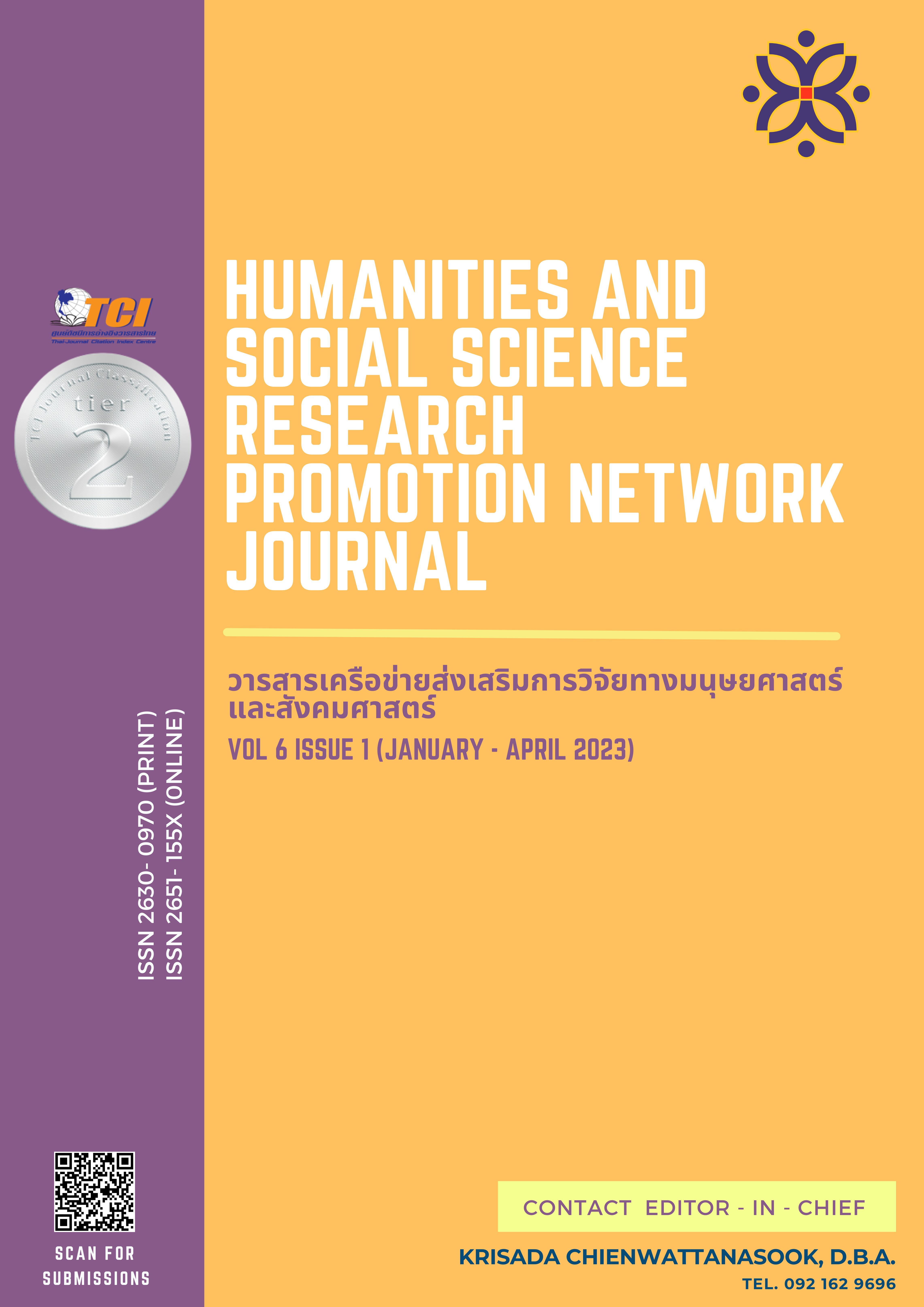ผลกระทบของเทคโนโลยีดิจิทัล (Digital HR) ต่อประสิทธิภาพการรับสมัครพนักงาน: กรณีศึกษาบริษัท Jilin Guancheng Construction Engineering Co., Ltd.
คำสำคัญ:
เทคโนโลยีดิจิทัล , ดิจิทัลเอชอาร์ , การรับสมัครพนักงานบทคัดย่อ
ธุรกิจหลายแห่งกำลังประสบปัญหาในการดึงดูดผู้บุคลากรที่มีความสามารถ โดยมีผลมาจากการแข่งขันที่เพิ่มขึ้น จึงมีการเรียกร้องให้นำกลยุทธ์ที่เป็นนวัตกรรมใหม่มาใช้ในกระบวนการสรรหาบุคลากร มีความเป็นไปได้ว่าเทคโนโลยีสำหรับทรัพยากรมนุษย์แบบดิจิทัล เช่น ระบบติดตามใบสมัครและกระดานงานออนไลน์อาจช่วยแก้ปัญหานี้ได้ อย่างไรก็ตาม ก่อนที่จะตัดสินใจนำสิ่งหนึ่งสิ่งใดมาใช้นั้น จำเป็นต้องทำการประเมินระดับความสำเร็จที่ได้รับจากการประยุกต์ใช้เทคโนโลยีเหล่านี้เป็นสิ่งสำคัญ การศึกษานี้มีวัตถุประสงค์เพื่อ 1) ศึกษาปัจจัยส่วนบุคคลที่มีผลต่อประสิทธิภาพการสรรหาพนักงานของ Jilin Guancheng Construction Engineering Co., Ltd. และ 2) ศึกษาเทคโนโลยีสำหรับทรัพยากรมนุษย์แบบดิจิทัลที่ส่งผลต่อประสิทธิภาพการสรรหาพนักงานของ Jilin Guancheng Construction Engineering Co., Ltd. ประชากรที่ใช้ในการวิจัยนี้ คือ พนักงาน เจ้าหน้าที่ และหัวหน้างานของบริษัท Jilin Guancheng Construction Engineering Co., Ltd. โดยใช้แบบสอบถามเป็นเครื่องมือที่ใช้ในการเก็บรวบรวมข้อมูลจากกลุ่มตัวอย่าง จำนวน 128 คน ด้วยวิธีการสุ่มแบบตามสะดวก ซึ่งมีความเชื่อมั่น ทั้งฉบับอยู่ที่ .977 ทำการวิเคราะห์ข้อมูลด้วยค่าความถี่ ร้อยละ ค่าเฉลี่ย ส่วนเบี่ยงเบนมาตรฐาน และทดสอบสมมติฐานด้วยการทดสอบที การวิเคราะห์ความแปรปรวนทางเดียว และการวิเคราะห์การถดถอยพหุคูณ
ผลการวิจัยพบว่า ความแตกต่างของปัจจัยส่วนบุคคล ได้แก่ เพศ และอายุ ที่แตกต่างกัน ส่งผลต่อประสิทธิภาพการรับสมัครพนักงานของบริษัท Jilin Guancheng Construction Engineering Co., Ltd. แตกต่างกัน อย่างมีนัยสำคัญทางสถิติที่ระดับ .05 และการใช้เทคโนโลยีดิจิทัลในการรับสมัครพนักงาน ได้แก่ การกำหนดตำแหน่งที่เปิดรับ การรวบรวมข้อมูลที่เกี่ยวกับงาน และการประเมินผลส่งผลต่อประสิทธิภาพการรับสมัครพนักงานของบริษัท Jilin Guancheng Construction Engineering Co., Ltd. อย่างมีนัยสำคัญทางสถิติที่ระดับ .05 โดยมีอำนาจในการพยากรณ์ร้อยละ 92
เอกสารอ้างอิง
Abbasi, S. G., Tahir, M. S., Abbas, M., & Shabbir, M. S. (2022). Examining the relationship between recruitment & selection practices and business growth: An exploratory study. Journal of Public Affairs, 22(2), e2438.
Agarwal, D., Bersin, J., Lahiri, G., Schwartz, J., & Volini, E. (2018). AI, robotics, and automation: Put humans in the loop. Deloitte Insights, 28.
Agarwal, D., Garg, P., & Srivastava, R.K. (2018). Examining the antecedents of employee engagement: A study of the Indian service industry. Global Business Review, 19(6), 1516-1535.
Armstrong, M. B., Landers, R. N., & Collmus, A. B. (2016). Gamifying recruitment, selection, training, and performance management: Game-thinking in human resource management. In Emerging research and trends in gamification (pp. 140-165). IGI Global.
Banerjee, P., & Gupta, R. (2019). Talent attraction through online recruitment websites: Application of web 2.0 technologies. Australasian Journal of Information Systems, 23, 1-23.
Becker, B., Huselid, M.A. & Beatty, R.W. (2009). The differentiated workforce: transforming talent into strategic impact. Harvard Business Review.
Carlson, K.D., Connerley, M.L., & Mecham, R.L. (2002). Recruitment evaluation: The case for assessing the quality of hires. Journal of Business and Psychology, 17(1), 5-23.
Chala, N., Poplavska, O., Danylevych, N., Ievseitseva, O., & Sova, R. (2022). Intrinsic motivation of Millennials and Generation Z in the new post-pandemic reality. Problems and Perspectives in Management, 20(2), 536-550.
Croitoru, G., Radu, F., Nitu, O., & Tileaga, T. (2012). Ways to increase the efficiency of recruitment, selection and employment strategies in large organizations from Dambovita county. In International Conference “Risk in Contemporary Economy” (pp. 237-242). Romania: University of Galati.
Dahlin, E. (2019). Are robots stealing our jobs? Socius: Sociological Research for a Dynamic World, 5, 1-14.
Deloitte Global Human Capital Trends. (2017). Rewriting the rules for the digital age. Retrieved from https://www2.deloitte.com/content/dam/Deloitte/global/Documents/About-Deloitte/central-europe/ce-global-human-capital-trends.pdf
Dyer, L. (1993). Team building: Issues and alternatives. Addison-Wesley.
Ensher, E. A., Nielson, T. R., & Grant-Vallone, E. (2002). Tales from the hiring line: effects of the internet and technology on HR processes. Organizational dynamics, 31(3), 224-244.
Gusdorf, M. L. (2008). Recruitment and selection: Hiring the right person. USA: Society for Human Resource Management, 1-14.
Hecklau, F., Galeitzke, M., Flachs, S., & Kohl, H. (2016). Holistic approach for human resource management in Industry 4.0. Procedia Cirp, 54, 1-6.
Huselid, M.A. & Becker, B. (1997). High-performance work systems and firm performance: A synthesis of research and managerial implications. Research in Personnel and Human Resources Management, 15, 53-101.
Huselid, M.A., Becker, B. & Beatty, R.W. (2005). The workforce scorecard: managing human capital to execute strategy. Harvard Business Press.
Khongsawatkiat, K., & Sukriket, P. (2021). The causal relationship model of human resource management to the organizational commitment of employees in agro-processing industries. Humanities and Social Science Research Promotion Network Journal, 4(1), 1-30.
Konya, L., Matić, J., & Pavlović, J. (2016). Employee engagement as a determinant of organizational performance. Ekonomika preduzeća, 64(3-4), 204-214.
Kulpeng, W. (2012). The impact of human resource management on organizational performance: Evidence from Thailand. Journal of Business and Management, 6(3), 59-66.
Martinho, F., Pinto Dos Reis, I., & Sampaio, M. C. (2019). Recruitment and Selection as a Tool for Strategic Management of Organizations–El Corte Ingles Case Study. Journal of Reviews on Global Economics, 2019(8), 1680-1688.
Minchington, B. (2014). Who must lead employer branding?: international waters-employer branding. HR Future, 2014(09), 14-17.
Nielsen, C., & Montemari, M. (2012). The role of human resources in business model performance: the case of network‐based companies. Journal of Human Resource Costing & Accounting, 16(2), 142-164.
Pajika, I., & Poompruk, C. (2022). Modifying the document storage process using the concept of design thinking to upgrade to a smart office. Journal of Value Chain Management and Business Strategy, 1(2), 54-66.
Pengcham, S. (2010). Employee engagement: Conceptualization and measurement. Kasetsart Journal of Social Sciences, 31(1), 18-25.
Pfeffer, J. (1994). Competitive advantage through people: Unleashing the power of the workforce. Harvard Business Press.
Pholsward, R. (2022). What graduates need in entering the job market. RICE Journal of Creative Entrepreneurship and Management, 3(3), 67-70.
Phoong, P. (2018). The relationship between employee engagement, organizational commitment, and job satisfaction: A study of employees in the tourism industry in Thailand. Journal of Human Resources in Hospitality and Tourism, 17(4), 443-465.
Ratanarotmongkol, W. (2020). The influence of employee engagement on organizational performance: A case study of a private hospital in Thailand. Journal of Health Management, 22(3), 322-331.
Saisit, S. (2006). Human resource practices, job satisfaction and organizational commitment. Thammasat Economic Journal, 24(1), 89-102.
Setyawati, N. W., Setianingsih, D. A., & Udin, U. (2019). The effect of recruitment and training on employee performance. International Journal of Scientific & Technology research, 8(10), 2663-2666.
Vijay, R., & Roopa, M. B. (2021). A study of recruitment practices and their impact on employee performance with reference to IT companies in Bangalore. Journal of Interdisciplinary Cycle Research, 13(3), 474-484.
Wantanang, K., Rasadaraksa, M., & Lamsomboon, N. (2020). E, employees diversity management influencing employees’ performance in one company providing air-cargo services. Social Science Journal of Prachachuen Research Network, 2(2), 46-61.
Yamane, T. (1973). Statistics: an introductory analysis. New York: Harper & Row.
ดาวน์โหลด
เผยแพร่แล้ว
รูปแบบการอ้างอิง
ฉบับ
ประเภทบทความ
สัญญาอนุญาต
ลิขสิทธิ์ (c) 2023 ซิ่วหยุน จาง, ภูมิพิชัย ธารดำรง

อนุญาตภายใต้เงื่อนไข Creative Commons Attribution-NonCommercial-NoDerivatives 4.0 International License.
บทความที่ได้รับการตีพิมพ์เป็นลิขสิทธิ์ของ ผู้เขียน
ทัศนะและความคิดเห็นที่ปรากฏในบทความในวารสารเครือข่ายส่งเสริมการวิจัยทางมนุษยศาสตร์และสังคมศาสตร์จะถือเป็นความรับผิดชอบของผู้เขียนบทความนั้น และไม่ถือเป็นทัศนะและความรับผิดชอบของกองบรรณาธิการ








